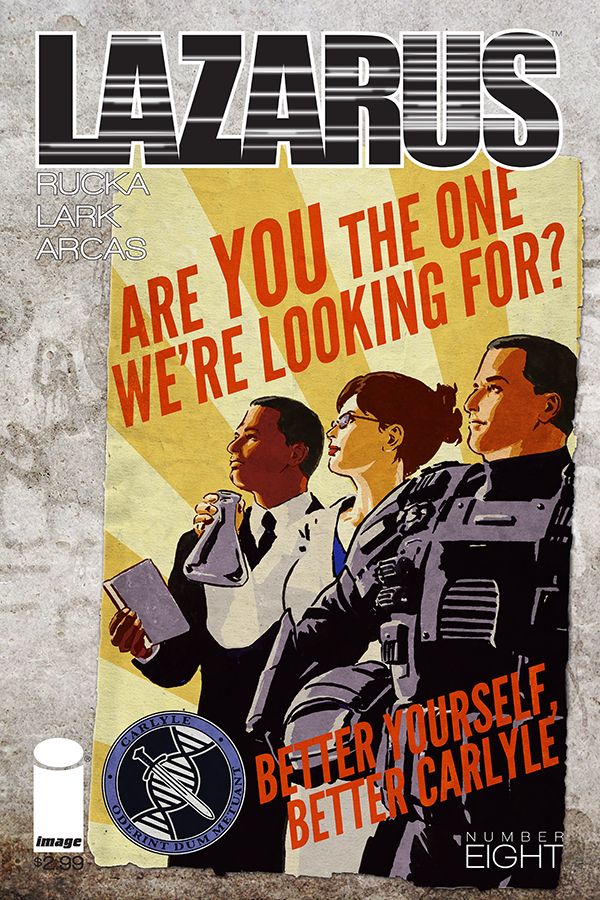In "Lazarus" #8 by Greg Rucka and Michael Lark, the clock starts ticking for Forever as the bomb plot she uncovers has unwelcome developments, while on the way to Lift Selection, Mike gets a surprising offer.
Rucka opens with a strong hook, showing Eve, barely any older than the last time readers saw her, working through an advanced battle scenario. Rucka achieves an excellent balance, making "Lazarus" accessible to the potential new reader without re-treading old territory too much. In particular, he reminds readers of the promised duel between Marisol and Eve through dialogue in a way that doesn't feel contrived, and letting the events speak for themselves.
The dialogue is realistic, especially for Eve, whose munching while she talks and excited speech patterns are endearing. It reminds readers of Eve's age, making her look vulnerable and cute in comparison to all the surrounding adults. As usual, Lark's art has superlative anatomy. Eve is instantly recognizable as a young Forever. She has the same features, and the same formidable focus and strength, but with softer lines in the face with just a trace of baby fat in her young girl's face and body.
Towards the end of the opening scene, Lark zeroes in for a shot of Eve's birthday gift, a copy of "The Once and Future King" by T. H. White. Not coincidentally, its themes are the same as those of "Lazarus": power and justice. It's about rulers and those who are ruled, about ideals of service vs. harsh realities. In "Lazarus" #8, it's clear that Eve grows to become knight to Malcolm's king, and Rucka's allusion here is sharp and smart, particularly because there's a potent contrast within between the touching enthusiasm of young Eve vs. the bloody, difficult duties of the adult Forever.
While "The Once and Future King" is very English, "Lazarus" is very American. Many dystopian societies have mechanism for its members to move between social classes, whether it's "Cinderella"-like marriage or civil service examinations or so on. In "Lazarus," the selection mechanism is "The Lift," which seems echo present-day American meritocratic principles of placing higher value on white-collar skills. The migration of the Waste to Life Selection is reminiscent of the treks of Okies in John Steinbeck's "The Grapes of Wrath," and Lark reinforces these impressions with clothing and landscape.
The other plotline, set among the Waste travelling to Lift Selection, is slower-paced. Rucka builds up a quick character sketch of Mike, managing to make him nerdy and selfless without being saintly. The ending introduces new characters, and while the cliffhanger ending to "Lazarus" #8 is predictable, it works well to tie the story back to Forever, and to foreshadow the impending convergence of The Free, the Barrets and the Carlyle Family at Lift Selection.
The ethical divisions between rich and poor are becoming fuzzier and grayer. In "Lazarus" #8, The Free rise into the foreground as Forever's investigation develops further. They are the first of the 99% that aren't 100% sympathetic. Rucka introduces a classic ethical dilemma -- means vs. ends -- as Forever has two of The Free interrogated brutally in order preserve Carlyle's plans for The Lift and potentially save lives.
Like in the execution scene in an earlier issue, Rucka and Lark preserve sympathy for Forever, first by having the violence of the interrogation occur off-screen, and secondly, through Lark's excellent facial expressions, which eloquently capture Forever's doubt, guilt and the strain on her conscience in her face as she confides in Joanna and as she receives her father's new orders. Wisely, Rucka and Lark just present this ethical dilemma to the reader without leading the reader by the nose to any definite judgment or conclusion about whether Forever's actions were justified. Just like in real life, there are no easy answers.
"Lazarus" #8 not only thickens the plot and deepens characterization; it also successfully engages and develops the complexity, scale and scope of Rucka and Lark's ambitious themes.

